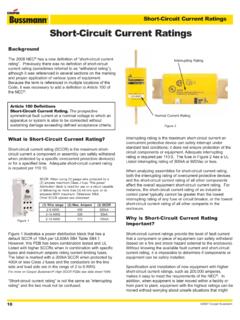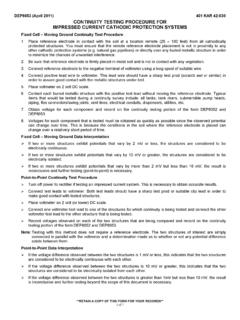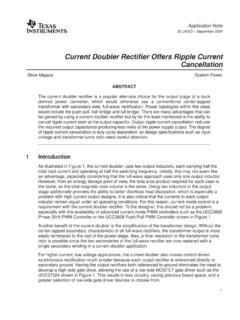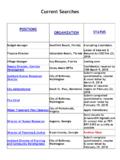Transcription of Guide to the Selection & Use of Residual Current …
1 Guide to the Selection & Use of Residual Current Devices ET214:2005. Edition 1. Electro-Technical Council of Ireland Limited Published by the Electro-Technical Council of Ireland Limited Date of Publication: 2005-02-11. Reissued 2006-01-26 with editorial correction to page (ii). 2005: The Electro-Technical Council of Ireland Limited. No part of this publication may be reproduced either mechanically of electronically or by photocopying without the written permission of the publisher. Electro-Technical Council of Ireland Limited, Unit H12, Centrepoint Business Park, Oak Road, Dublin 12. Telephone: (01) 429 0088. Fax: (01) 429 0090. E-mail: Website: Whilst every effort has been made to ensure that this Guide provides accurate and expert guidance, it is impossible to predict all the circumstances in which it may be used.
2 Accordingly the authors, the publishers ETCI, its committees and members shall not be liable to any person or entity with respect to any loss or damage caused or alleged to be caused directly or indirectly by omissions, content or any error contained in this Guide . Contents Section 1 Introduction, Objective & Scope Introduction Objective Scope Definition & Principle of Operation Section 2 Regulatory Requirements Regulatory Requirements RCD Product Standards Installation Rules Assembly Requirements Section 3 RCD Product Types Product Names/Types RCD Technology Supply Voltage Response Values of Rated Residual Operating Current Types of Residual Current Operating Times Poles and Number of Poles Section 4 Application of RCDs Shock & Fire Protection Protected Circuits Section 5 Selection & Installation of RCDs Factors influencing behaviour of RCDs Installation & Load Characteristics RCD characteristics Overcurrent Protection Section 6 Testing Testing ET214.
3 2005 Contents (i). Foreword This Guide has been prepared by the ETCI Residual Current Devices Task Force (RCD TF). RCD TF Members: Chairman Mr. Jeremiah O'Dwyer Secretary Mr. Brian Abbott Members Mr. Pat Ward Western Automation R & D Ltd Mr. Liam Kenny KLM Limited ET214:2005 Foreword (ii). Section 1 Introduction, Objective & Scope Introduction This Guide is intended to provide guidelines for the Selection , installation and use of Residual Current Devices (RCDs). The Guide is likely to be of benefit to electrical contractors, specifiers, and persons wishing to gain a wider understanding of the use of RCDs. Objective This Guide is intended to provide specifiers, installers and users of RCDs with a better understanding of the application, Selection and use of such products.
4 However, it is important to note that this Guide is intended for use as a Guide only, and has no regulatory or statutory status. This Guide should therefore be used in conjunction with the Current issue of the National Rules for Electrical Installations (ET101), relevant product standards, and EN60439 Low Voltage Switchgear and Control Gear Assemblies, where applicable. Scope This Guide is limited to RCDs intended for domestic and similar use, having a rated voltage not exceeding 400V AC and a rated Current not exceeding 125A. Definition & Principle of Operation By definition, an RCD is a device or association of devices designed to cause the opening of one or more contacts when the Residual Current flowing in the circuit protected by the RCD reaches the rated Residual operating Current (I N) of the device.
5 In an electrical installation, Current will flow from the supply to a load and back to the supply. The load can be connected between phases or between phases and neutral on multiphase installations, or between phase and Neutral on a single phase installation. Under perfect conditions, the magnitude of the Current flowing to the load will equal the magnitude of the Current returning from the load back to the supply. Any difference in the Current flowing to the load and returning from the load is known as a Residual Current . Under earth fault conditions, a Current will flow to earth, giving rise to a Residual Current . An RCD comprises means to detect a Residual Current , means to compare the Residual Current with the rated Residual operating Current of the device, (usually a relay for electromechanical RCDs or an electronic circuit for electronic RCDs), and means for removing the supply to the protected circuit (a circuit breaker element) when the Residual Current exceeds the rated Residual operating Current of the device.
6 ET214:2005 Introduction, Objective & Scope 1. Section 2 Regulatory Requirements Regulatory Requirements. The Low Voltage Directive (LVD) is a European Union Directive which, in its simplest form, requires that products placed on the EU market shall be safe. European Harmonised Standards may be used to demonstrate compliance with the essential requirements of the Directive and are the recommended route to establish compliance with the law. The LVD first came into force in 1973, and was revised in 1995 to include a requirement that the CE Mark be placed on relevant equipment marketed within the EU. The EMC (Electromagnetic Compatibility) Directive places limits on emissions from electrical products, and requires that electrical products have the required level of immunity in order to function correctly in their operational environment.
7 EMC. requirements are generally specified in the relevant product standard. The CE mark is a statement by the manufacturer that equipment complies with the requirements of all applicable EU Directives, which in the case of RCDs specifically include the LVD and EMC Directive. CE marking of products covered by the LVD. became mandatory in January 1997. On the basis of the above, all RCDs supplied to the Irish market are required to have a CE marking. RCD products which fail to bear the CE marking should not be used. RCD Product Standards IEC (the International Electrotechnical Commission) is the world body responsible for international standardisation within the electrical industry. CENELEC is the body responsible for standardisation in the electrical industry in Europe.
8 It is CENELEC policy to achieve harmonised standards for products and procedures within the member countries where possible, and it achieves this mainly by adopting IEC standards. CENELEC product standards are referred to as European Standards (ENs), and where an EN cannot be agreed ( for reasons of incompatibility between member states), a Harmonisation Document (HD) may be prepared. For the purpose of implementing the CENELEC harmonisation policy, member states should adopt ENs or HDs, and in the absence of a relevant EN or HD, preference should be given to an IEC standard, and in the absence of an IEC standard a National Standard may be used. Each member country adds a prefix to the relevant standard for national use.
9 In the case of Ireland, the prefix is (Irish Standard). ET214:2005 Regulatory Requirements 2. The relevant standards covering RCD products for use in Ireland are as follows. EN61008-1: Electrical Accessories Residual Current Operated Circuit-Breakers Without Integral Overcurrent Protection for Household and Similar Uses (RCCBs) Part 1: General Rules. EN61008-2-1: Residual Current Operated Circuit-Breakers Without Integral Overcurrent Protection for Household and Similar Uses (RCCBs) - Applicability of the General Rules to RCCBs Functionally Independent of Line Voltage. IEC61008-2-2: Residual Current Operated Circuit-Breakers Without Integral Overcurrent Protection for Household and Similar Uses (RCCBs) - Part 2-2: Applicability of the General Rules to RCCBs Functionally Dependent of Line Voltage.
10 EN61009-1: Electrical Accessories Residual Current Operated Circuit-Breakers With Integral Overcurrent Protection for Household and Similar Uses (RCBOs) General Rules. EN61009-2-1: Residual Current Operated Circuit-Breakers With Integral Overcurrent Protection for Household and Similar Uses (RCBOs) - Applicability of the General Rules to RCBOs Functionally Independent of Line Voltage. IEC61009-2-2: Residual Current Operated Circuit-Breakers With Integral Overcurrent Protection for Household and Similar Uses (RCBOs) - Part 2-2: Applicability of the General Rules to RCBOs Functionally Dependent of Line Voltage. EN60947-2: Low Voltage Switchgear and Controlgear Circuit Breakers (Annex B, Circuit Breakers Incorporating Residual Current Devices).








